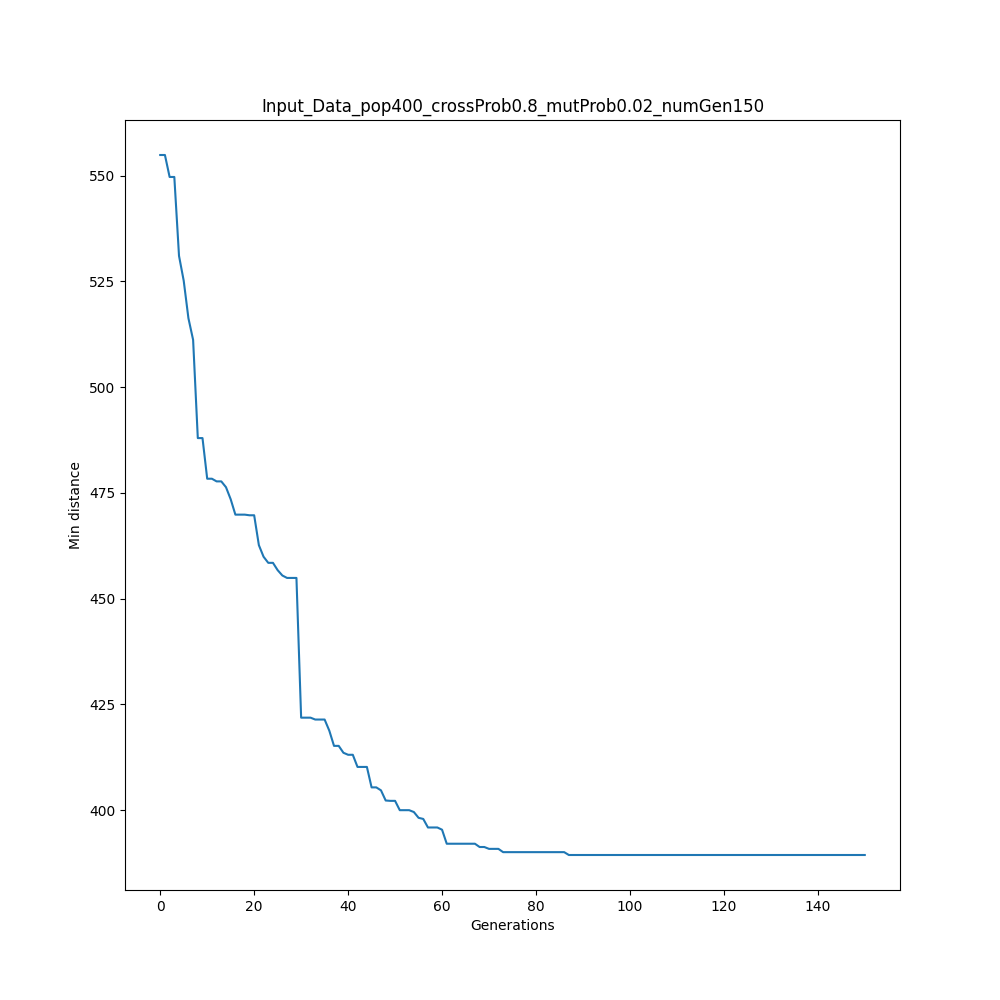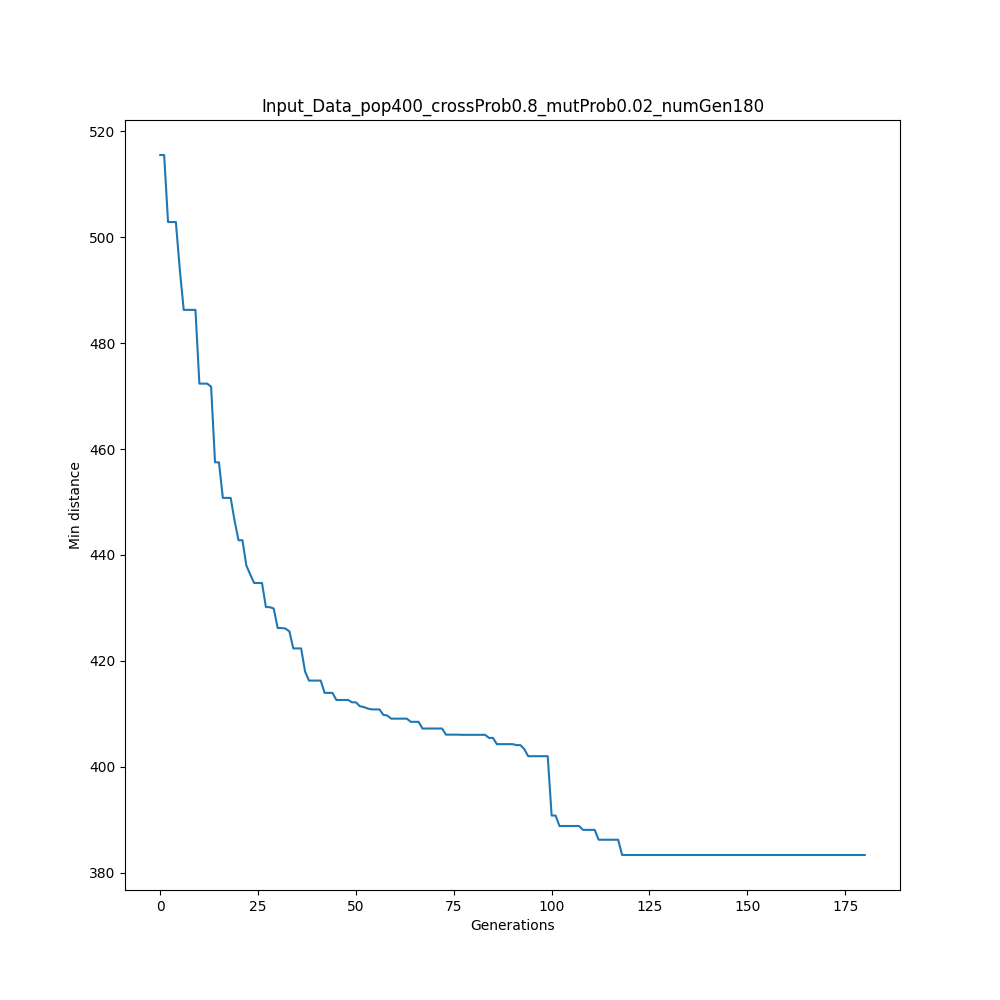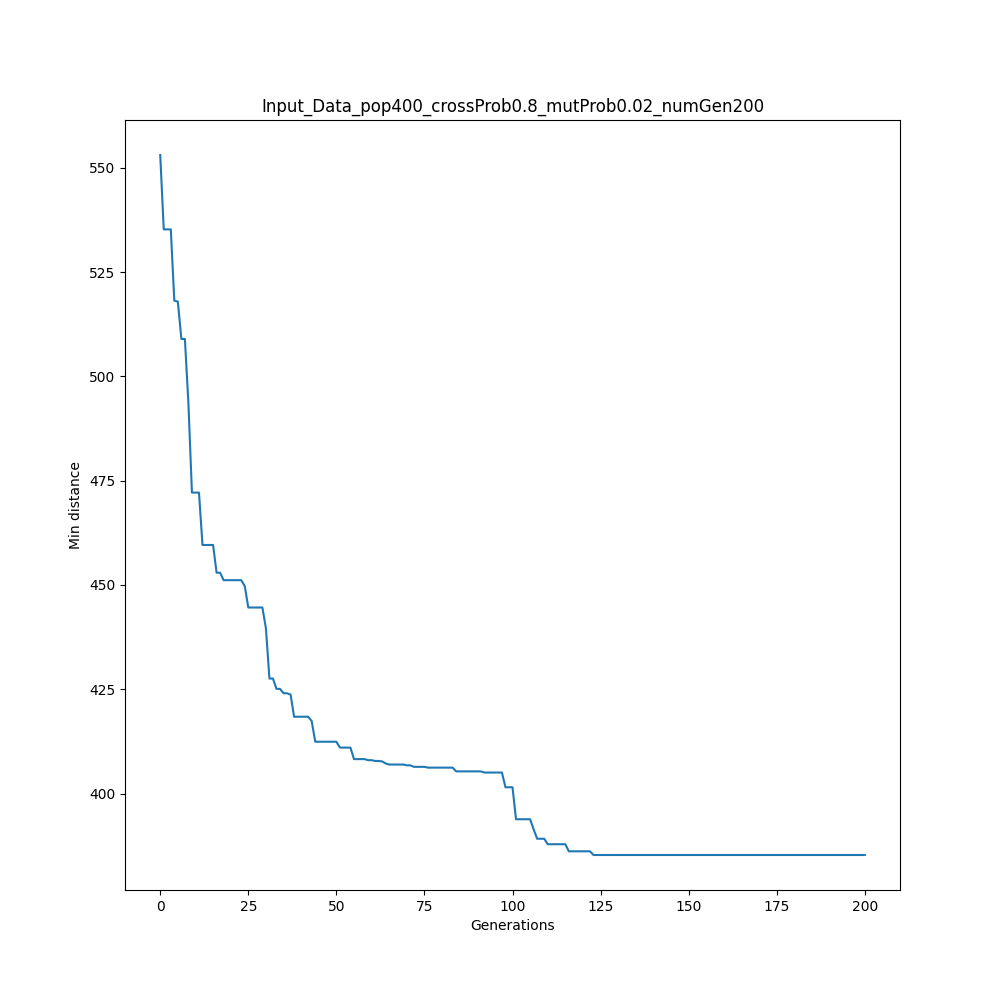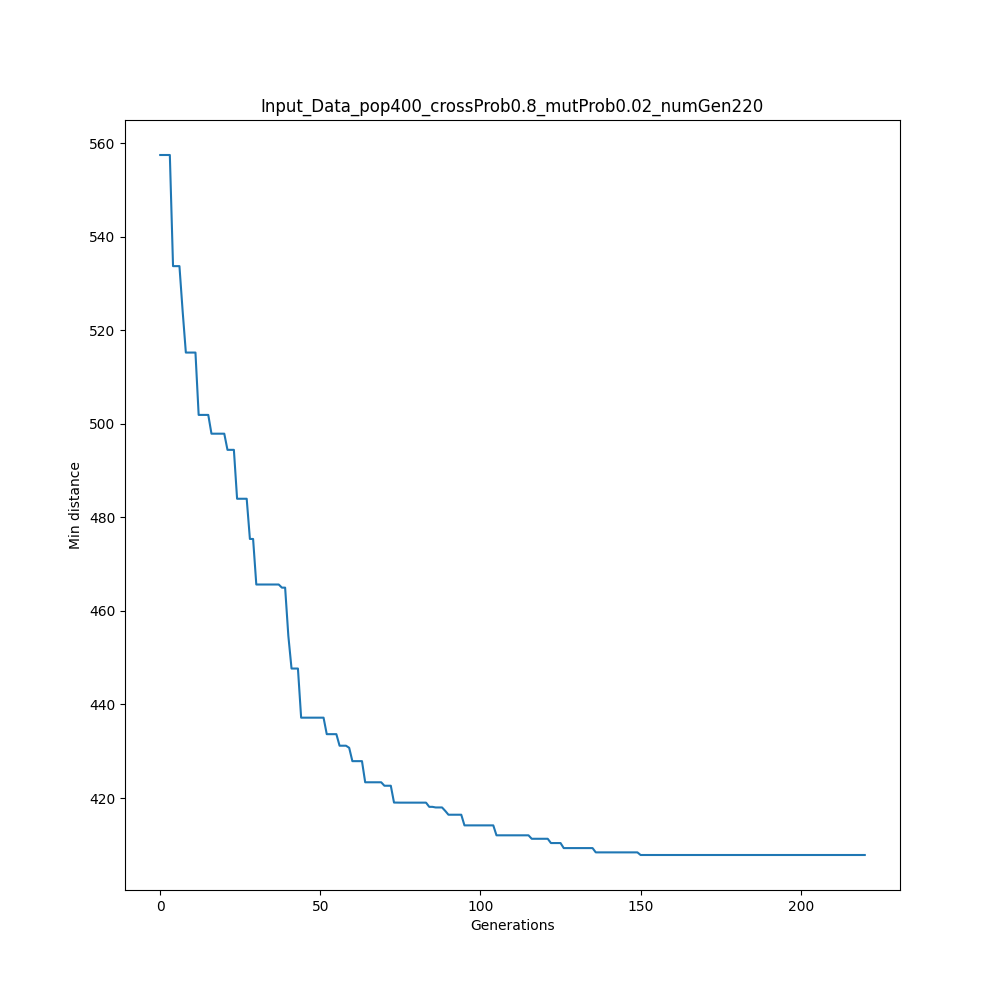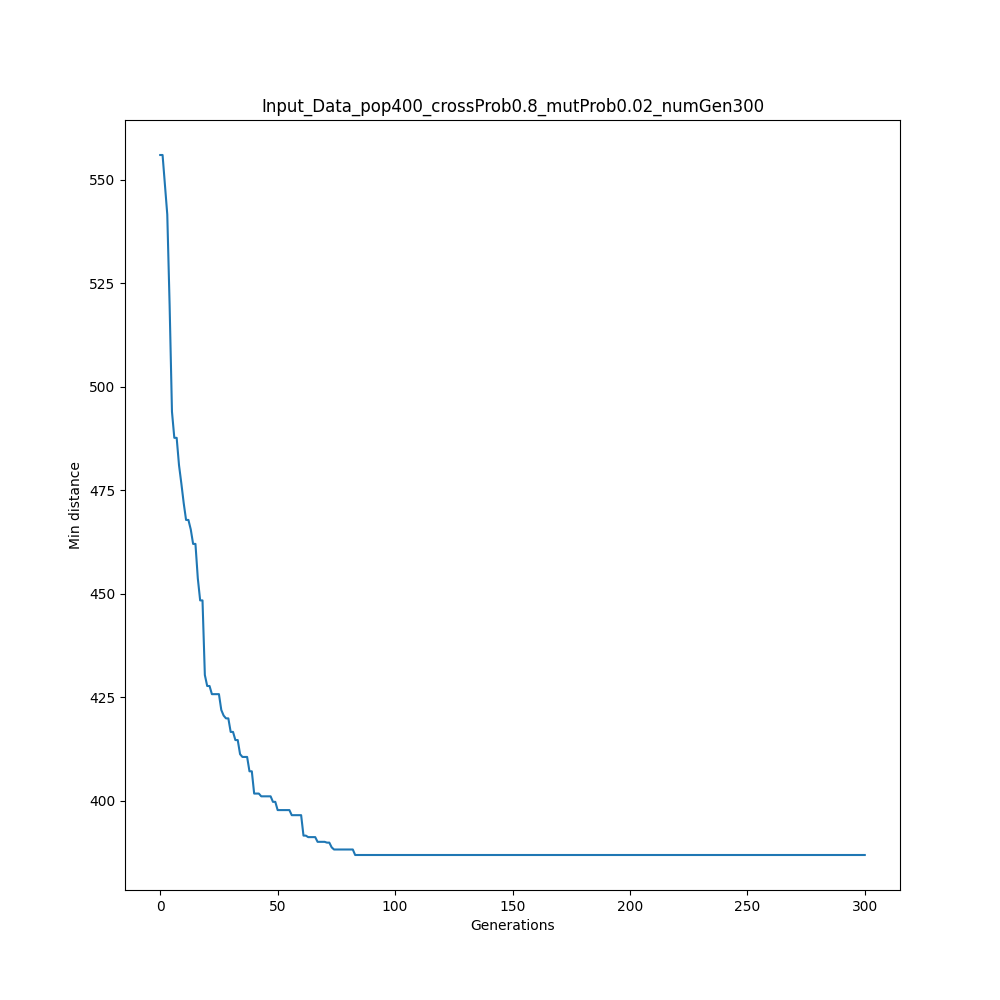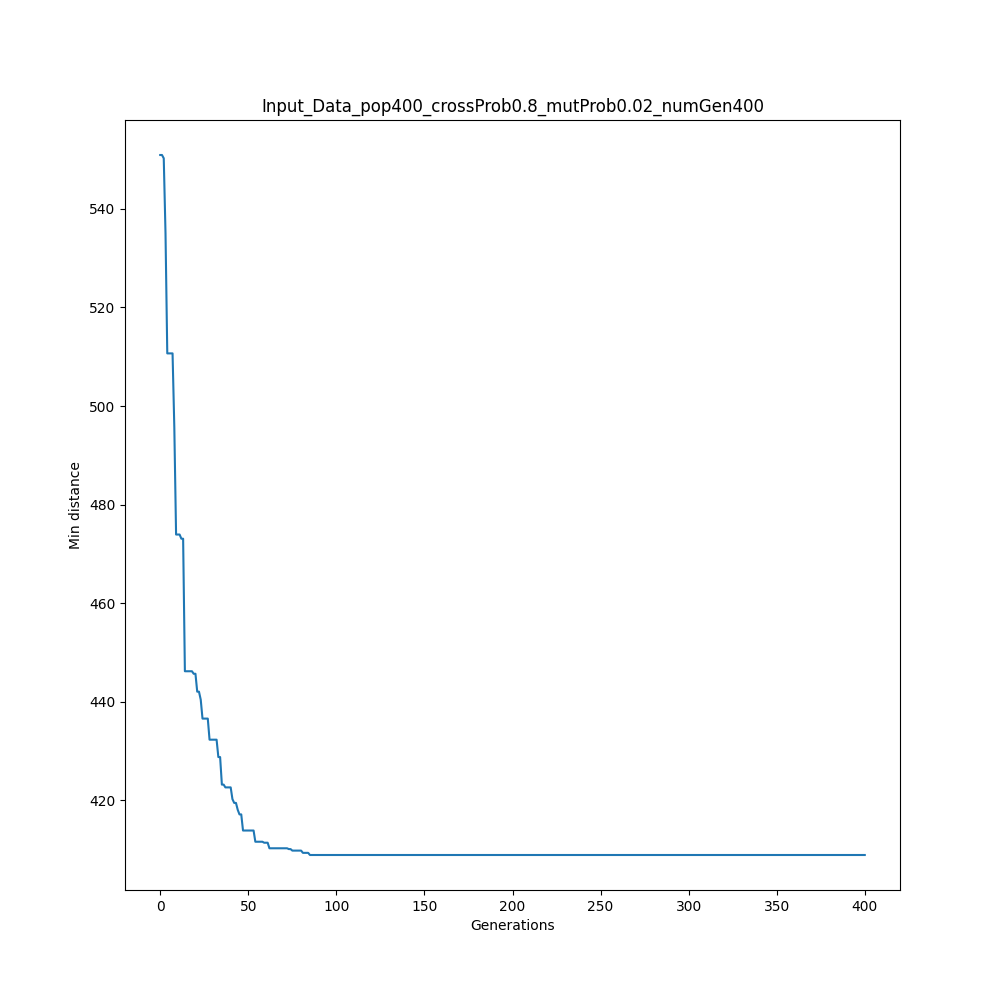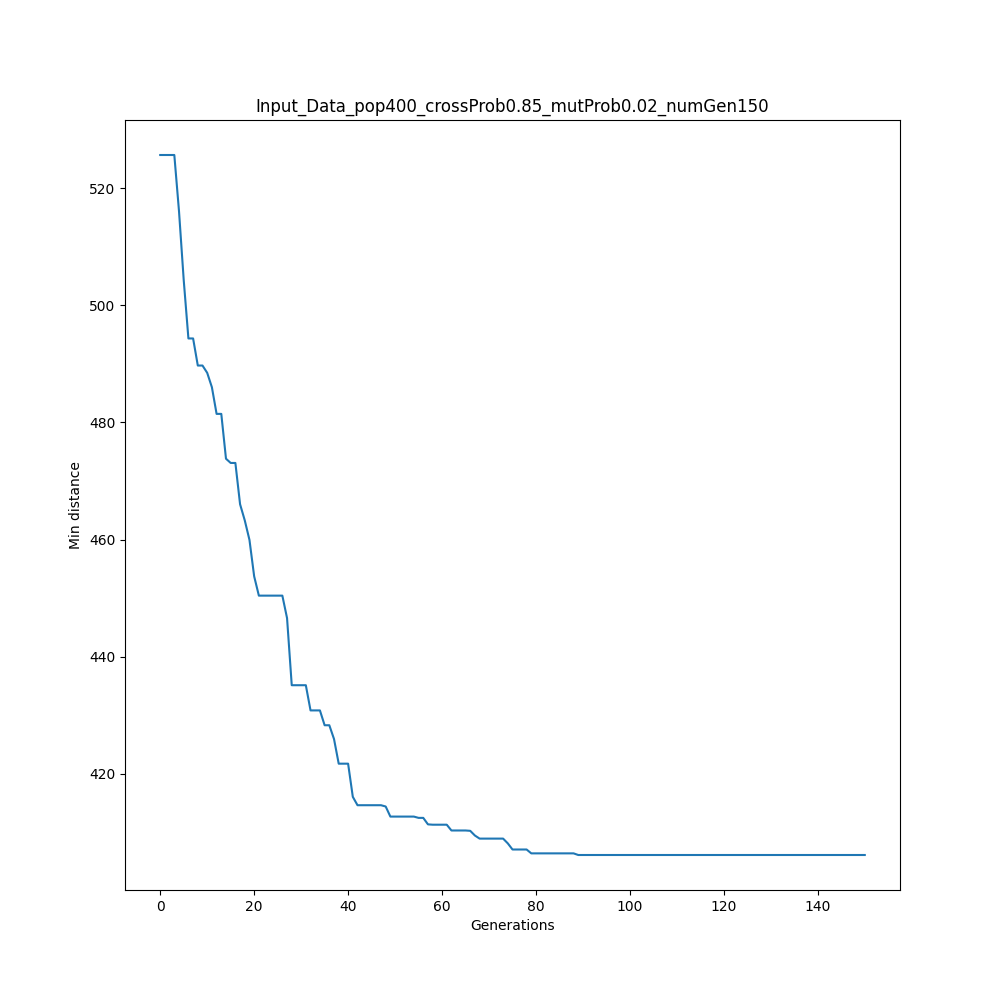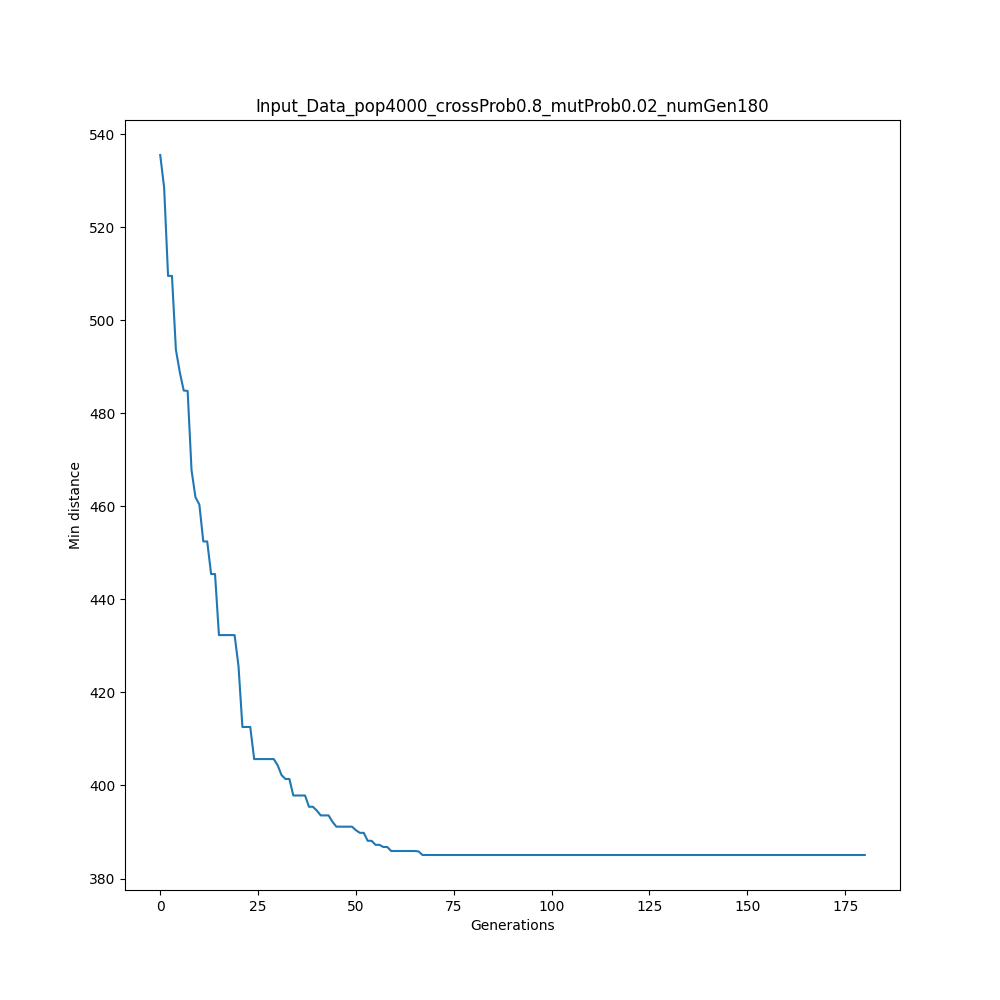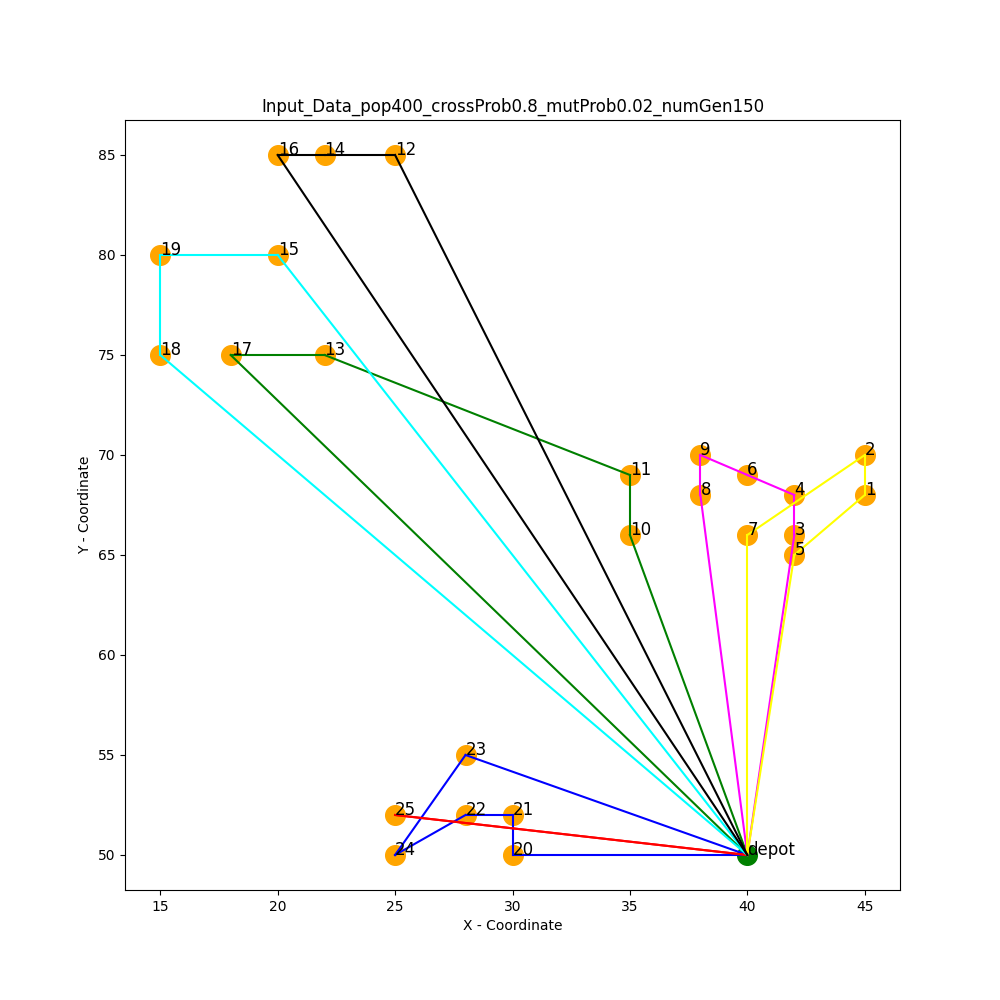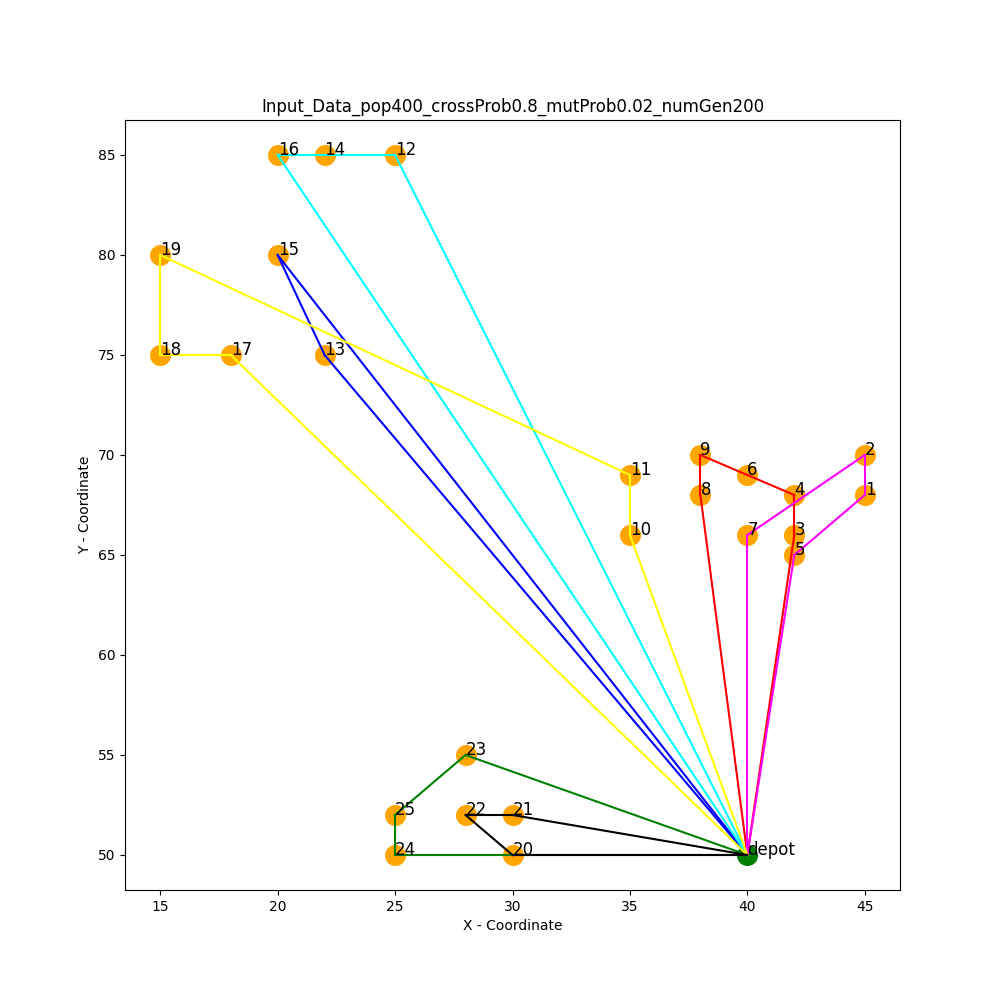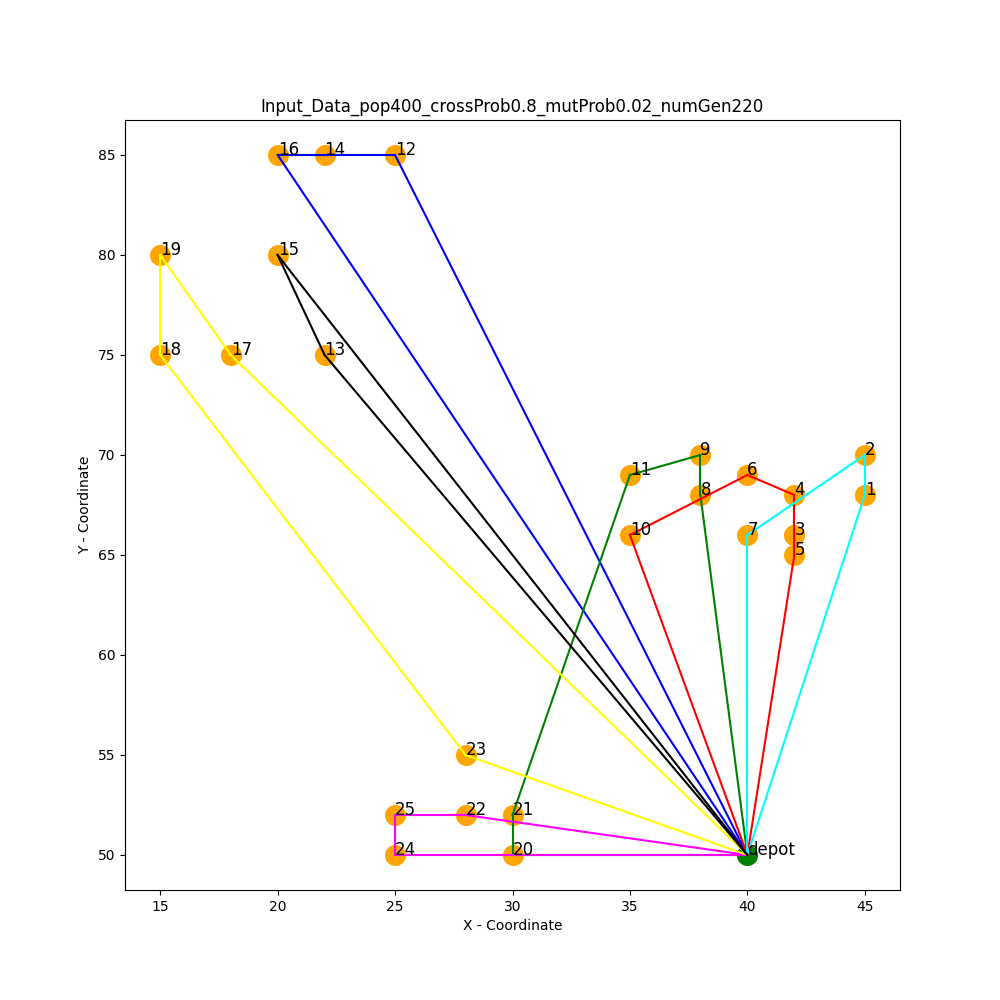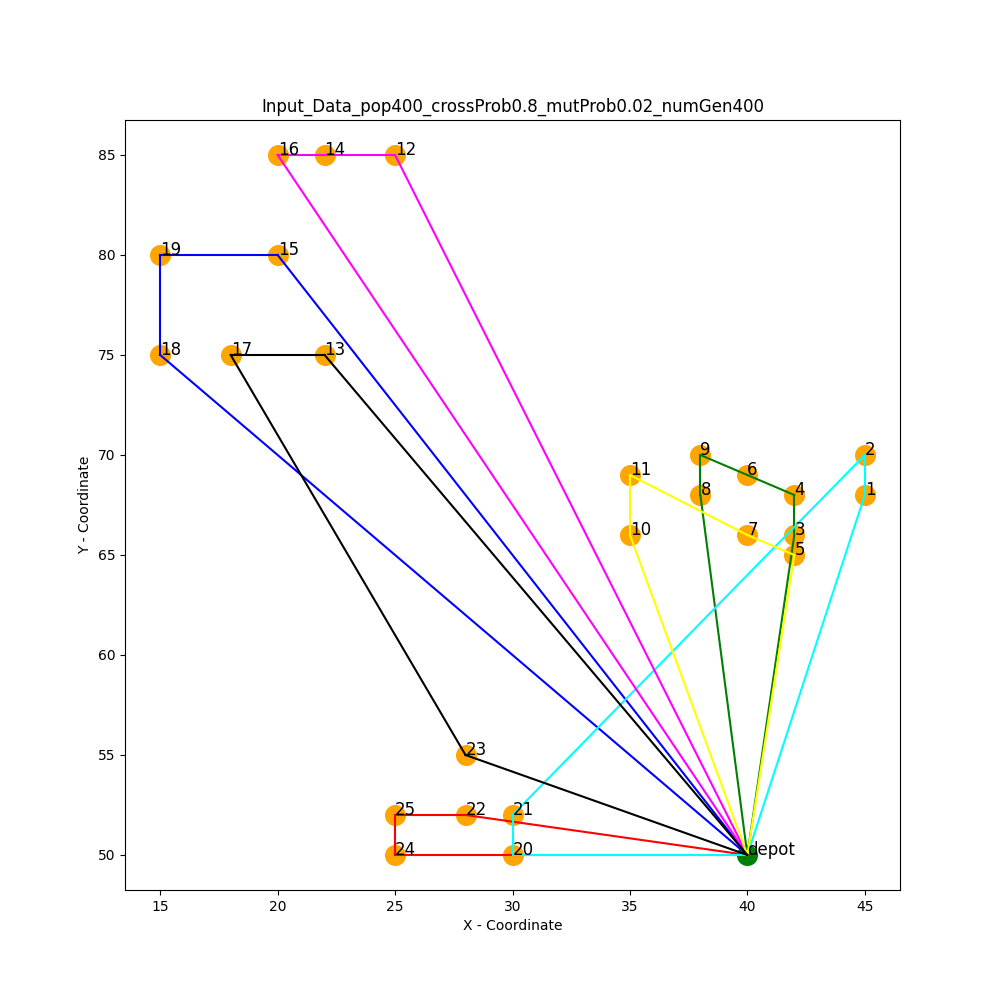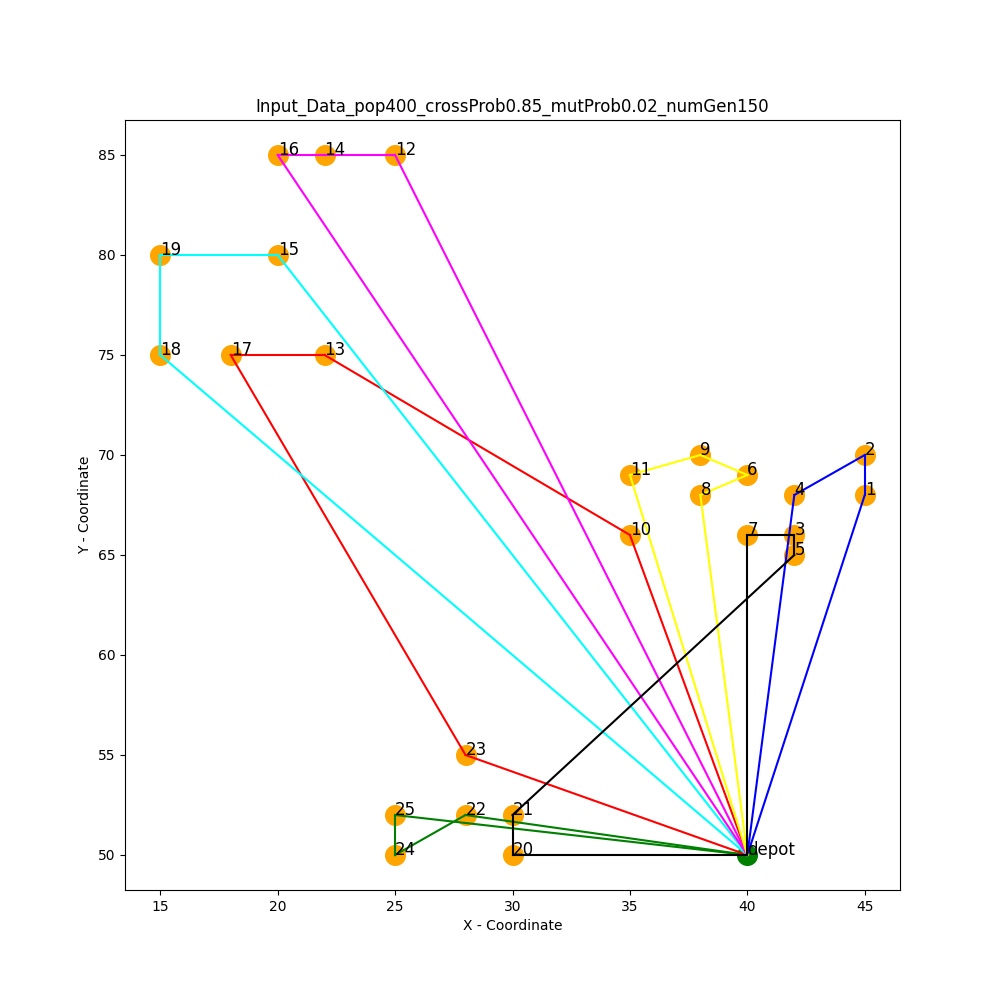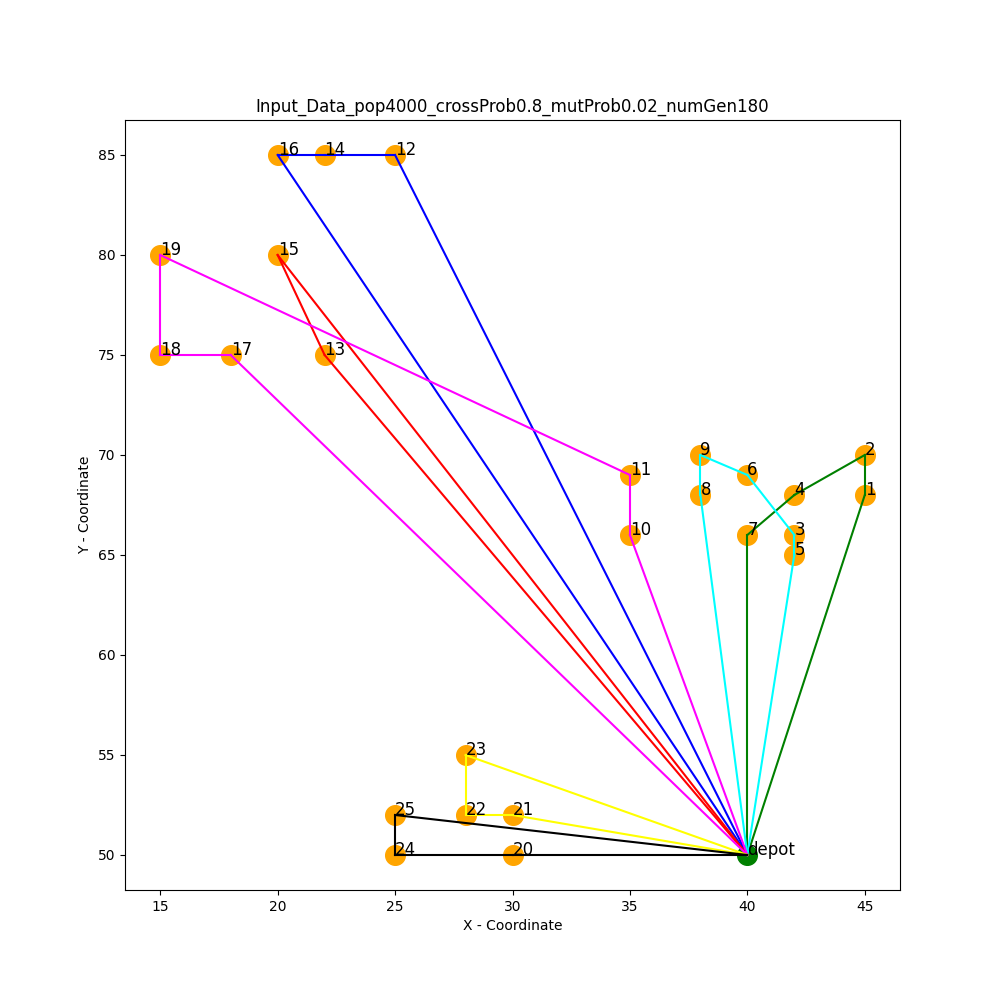Multiobjective python implementation of capacitated vehicle routing problem with NSGA-II algorithm using deap package.
On Unix, Linux, BSD, macOS, and Cygwin:
git clone https://github.com/icav_vrp.git
cd icav_vrp
virtualenv --python=python3 venv
source venv/bin/activate
pip install -r requirements.txtDelivery companies every day need to deliver packages to many different clients. The deliveries are accomplished using an available fleet of vehicles from a central warehouse. The goal of this exercise is to design a route for each vehicle so that all customers are served, and the number of vehicles (objective 1) along with the total traveled distance (objective 2) by all the vehicles are minimized. In addition, the capacity of each vehicle should not be exceeded (constraint 1)
Notes
- For each client we have we only need to consider first four fields. They are
id, xcoord, ycoord, demand - Distance between each client can be calculated using
Euclidian formula
The text files for this problem which are inputs provided can be found in the
data/text directory. Text file is named as Input_Data.txt.
The description of the format of the text file defined in the problem instance
<Instance Name>
<empty line>
VEHICLE
NUMBER CAPACITY
K Q
<empty line>
CUSTOMER
CUST NO. XCOORD. YCOORD. DEMAND READY TIME DUE DATE SERVICE TIME
0 40 50 0 0 1236 0
1 45 68 10 0 1127 90
2 45 70 30 0 1125 90
.......
n x_n y_n d_n r_n due_n s_n
Definitions
CUST No.0 denotes the depot , where all vehicles start and finishKdenotes maximum number of vehicles that are availableQdenotes maximum capacity of each vehiclendenotes the maximum number of customers in the given problem, excluding the depot
Since text file is pretty bad to behave in object oriented way , we are converting
given text input file into JSON format. And they are stored under data/json directory.
The file name of these json file is same as text file and it can be named as instance in the
code. Since our problem is Input_Data.txt our json file will be Input_Data.json.
Notes
- We are adding additional fields here such as
Number_of_customers,distance_matrixwhich are calculated fromInput_Data.txt. distance_matrixcontains distances from each customer to other with first array being distances from depot.- If a json file doesn't exist at the
data/jsondirectory , when we runparseText2Jsonit creates json file. If it exists its overwritten.
Below is description of the JSON format.
{
"instance_name" : "<Instance name>",
"Number_of_customers" : n,
"max_vehicle_number" : K,
"vehicle_capacity" : Q,
"depart" : {
"coordinates" : {
"x" : x0,
"y" : y0
},
"demand" : q0,
"ready_time" : e0,
"due_time" : l0,
"service_time" : s0
},
"customer_1" : {
"coordinates" : {
"x" : x1,
"y" : y2
},
"demand" : q1,
"ready_time" : e1,
"due_time" : l1,
"service_time" : s1
},
...
"customer_n" : {
"coordinates" : {
"x" : x_n,
"y" : y_n
},
"demand" : q100,
"ready_time" : e100,
"due_time" : l100,
"service_time" : s100
},
"distance_matrix" : [
[dist0_0, dist0_1, ..., dist0_n],
[dist1_0, dist1_1, ..., dist1_n],
...
[distn_0, distn_1, ..., dist0_0]
]
}Run the parseText2Json.py to convert *.txt file to *.json file.
python parseText2Json.pyTo run the algorithm activate the virtual environment that you have named and run this command
python runAlgo.py Additionally you can specify arguments to change the hyperparameters or even file names. The following arguments are available
python runAlgo.py --popSize=300 --crossProb=0.7 --mutProb=0.01 --numGen=320--pop_size: Specify the number of population that is generated--crossProb: Cross over probability that needs to be considered--mutProb: Mutation probability--numGen: Number of generations that you want the algorithm to run
On doing so the above, the following result file will be generated in the results directory
Input_Data_pop300_crossProb0.7_mutProb0.01_numGen320.csv which can later be used to plot results from them.
Multiobjective optimization of travelling salesman is a NP-hard problem. So simple Genetic algorithm cannot compute good solutions when there are multiple objectives. We need a non dominated sorting approach where only non dominated inviduals are selected. Another way of formulating this problem is to use genetic algorithm but combining both objectives into a single one.
Here our objective is
Minimize -> Number of vehicles
Minimize -> Distance travelled by all vehicles
This can be formulated in another way like this
Minimize -> (Number of vehicles) * (Distance travelled by all vehicles)
---- or -----
Maximize -> 1/ (Num of vehicles) *(Distance by all )
We are assuming the following things.
- There is no time delay and no time windows for our vehicle at the objective locations
- Fixed cost for extra vehicle is assumed to be 0.
- Due date, service time , ready time are Ignored
- Distance between client to client is assumed to be Euclidean.
- Vehicle always starts from the depot
customer_0and delivers goods and then comes back to depot again after delivery
All visited customers of a route (including several sub-routes) are coded into an individual in turn. For example, the following route
Sub-route 1: 0 - 5 - 3 - 2 - 0
Sub-route 2: 0 - 7 - 1 - 6 - 9 - 0
Sub-route 3: 0 - 8 - 4 - 0
are coded as 5 3 2 7 1 6 9 8 4, which can be stored
in a Python list object, i.e., [5, 3, 2, 7, 1, 6, 9, 8, 4].
The route of is given as sequence of customers , but it is actually divided in to subroutes according to the load carrying capacity of the vechicle. Starting from the depot demand from each customer is added and when the load exceeds the vechicle capacity the subroute is closed and assigned to that vechicle. This process is repeated until all the customers in the sequence is fulfilled. Thus we will get subroutes from routes and number of subroutes is equivalent to number of vechicles.
routeToSubroute(individual, instance)Decodes an individual to route. Refer the below example
# Individual
[12, 14, 16, 8, 9, 11, 21, 20, 5, 3, 4, 6, 10, 7, 2, 1, 22, 25, 24, 23, 18, 19, 17, 15, 13]
# Route
[[12, 14, 16], [8, 9, 11, 21, 20], [5, 3, 4, 6, 10], [7, 2, 1], [22, 25, 24], [23, 18, 19, 17], [15, 13]]Since our problem is Multiobjective , we need to calculated two objectives here
One is Number of vehicles and Total Distance Travelled
So we divided the objectives, calculate them and return a tuple
First objective is calculated using getNumVehiclesRequired function
which just finds number of elements in list after the Indiviudal is
passed in to routeToSubroute
Second objective is caclulated using getRouteCost.
After dividing an individual in to sub routes, For each subroute distance
is calculated between indiviudals and added. Final Route cost will be
addition of all these sub routes cost
eval_indvidual_fitness(individual, instance, unit_cost)This function returns a tuple of (Num of vehicles, Route Cost)
We have to minimize both the objectives at same time.
So when we create our individual using deap package, we have to specify the
individual in following way -
creator.create('FitnessMin', base.Fitness, weights=(-1.0, -1.0))Assigning weights (-1.0, -1.0) is crucial step when defining objective.
Apply NSGA-II selection operator on the individuals. Usually, the size of individuals will be larger than k because any individual present in individuals will appear in the returned list at most once. Having the size of individuals equals to k will have no effect other than sorting the population according to their front rank. The list returned contains references to the input individuals. For more details on the NSGA-II operator see Deb2002.
From a group of individuals, it selects k number of inviduals for next
generation. First, all the individuals are assigned crowding distance.
The algorithm works as follows -
- First parent
Ptand offspring populationQtare combined to formRt - Fast non dominated sorting is performed over combined population, to find Pareto Fronts
- Now next generation parent Population say Pt+1 is to be filled
- Assign crowding distance in Each pareto front
- If population length doesn't exceed initial parent population, add this population
to
Pt+1, Repeat this process until this condition is overridden
- Now we are in say some Pareto front
Fiand we have to addN-Pt+1population- Sort all individuals in
Fiusing<crowded operator - Keep adding new population until it doesn't reach
N
- Sort all individuals in
- Now
Nindividuals are selected for next generation - Perform
CrossoverandMutationoperations over these population - This new population is
Qt+1, aka.,offspring - Repeat 1-7 until all generations are complete.
selNSGA2(individuals, k, nd='standard')Ordered crossover will never give us invalid and infeasible individuals or routes which have same customer multiple times. This helps us in computing fitness values without rechecking if an individual is valid or not.
Executes an ordered crossover (OX) on the input
individuals. The two individuals are modified in place. This crossover
expects :term:sequence individuals of indices, the result for any other
type of individuals is unpredictable.
Moreover, this crossover generates holes in the input individuals. A hole is created when an attribute of an individual is between the two crossover points of the other individual. Then it rotates the element so that all holes are between the crossover points and fills them with the removed elements in order. For more details see [Goldberg1989]
cxOrdered(ind1, ind2)Ordered CrossOver works as follows -
Lets say we have two routes A and B as follows
A = 9 8 4 5 6 7 1 3 2 10
B = 8 7 1 2 3 10 9 5 4 6
Here we select two random positions in A and B
say we select 3 and 6
A = 9 8 4 | 5 6 7 | 1 3 2 10
B = 8 7 1 | 2 3 10 | 9 5 4 6
Now , ordered crossover uses sliding motion to left to fill the holes
by transferring mapped positions. For example, when string B maps to string A,
the cities 5, 6, 7 will leave hoes in string B
B = 8 H 1 | 2 3 10 | 9 H 4 H
Now these holes are filled with a sliding motion towards left.
To understand this in better way imagine that holes H are rocks and
middle portion in between | | is a pond, rest numbers will float but only in the
first and last regions. Say that if hole H comes in pond it is stuck there and cant get out.
And also all the numbers in the right tail that is 9 * 4 * are also stuck there.
So , we start moving entire thing slowly left,
After 1 digit displacement towards left
B = H 1 2 | 3 10 H | 9 4 H 8
After another digit displacement
B = 1 2 3 | 10 H H | 9 4 8 H
After another digit displacement
B = 2 3 10 | H H H | 9 4 8 1
Remember that H cannot escape in between | | and alos numbers cannot escape the last tail
After full sliding motion and filling portion in between | |
we have the following B
B = 2 3 10 | H H H | 9 4 8 1
Similarily repeating this process for A -
A = 9 8 4 | 5 6 7 | 1 H H H
After 1 digit displacement towards left
A = 8 4 5 | 6 7 H | 1 H H 9
After another digit displacement
A = 4 5 6 | 7 H H | 1 H 9 8
After another digit displacement
A = 5 6 7 | H H H | 1 9 8 4
Now we just have to swap middle portions that are cut in first place and we have two new individuals. They will be -
A_new = 5 6 7 | 2 3 10 | 1 9 8 4
B_new = 2 3 10| 5 6 7 | 9 4 8 1
Ultimately we swapped 5, 6, 7 cities from A and 2 3 10
cities from B to each other , but no repeatation of cities in both
A_new and B_new
Inverses the cities between two random points of input individual and returns new one. The mutation is controlled by mutation probability and is executed over all the offspring population.
A = 5 6 7 2 3 10 1 9 8 4
Say our mutation probability is 0.02 and randomly we selected
position 4 and 8
So our new individual will be
A = 5 6 7 9 3 10 1 2 8 4
We used python inbuilt unittest module to run all the tests
To run all the tests do the following
python -m unittest discover testThis command will discover all the tests in the test folder and runs them all.
Plots are generated for Minimum fitness values for each combination of parameters with respect to population generations. Vechicle routing plots are generated as well where each color represents a route taken by a vehicle. The final combination of routes is the best route that is generated at the end of generations for each combination of parameters
├── data/
│ ├── json/
│ │ ├── <Instance name>.json
│ │ └── ...
│ ├── text/
│ │ ├── <Instance name>.txt
│ │ └── ...
├── figures/
│ ├── Input_Data_... .png
│ └── ...
├── plots/
│ ├── __init__.py
│ └── plotGenerations.py
│ └── plotVehicleRoutes.py
├── results/
│ └── ...
├── nsga_vrp/
│ ├── __init__.py
│ ├── NSGA2_vrp.py
│ └── utils.py
├── test/
│ ├── __init__.py
│ ├── test_distance.py
│ └── test_route.py
├── parseText2Json.py
├── plotAllResults.py
├── runAlgo.py
├── requirements.txt
├── README.md
├── LICENSE
└── .gitignore
Distributed Evolutionary Algorithms in Python
- Test cases for mutation , crossover and selection
- Web based interface to Input data and see the graphs and Optimal route
- Comparison of frameworks and hyperparameter optimization
- Gifs of transporation route and how is it changing with generations
MIT License
